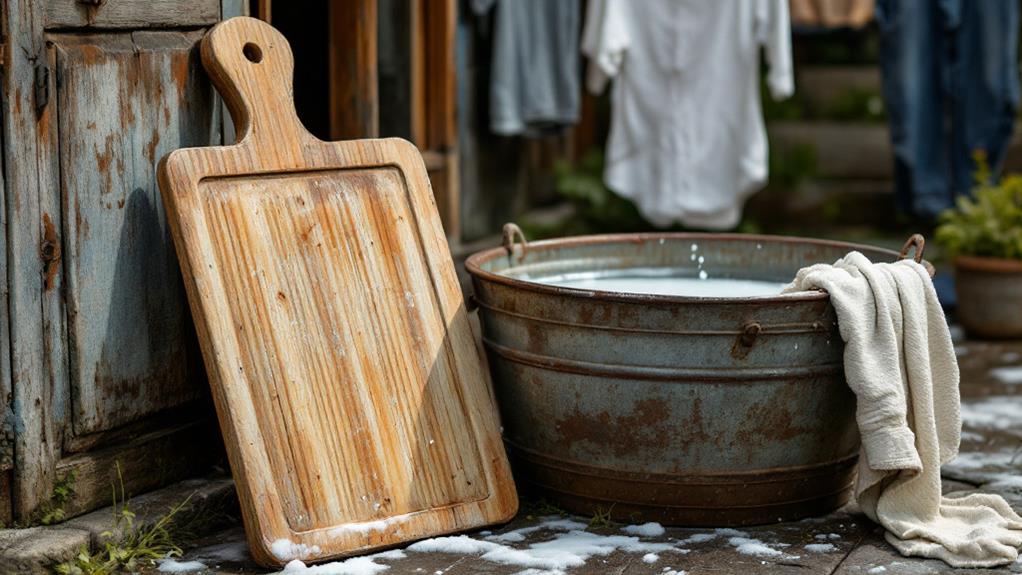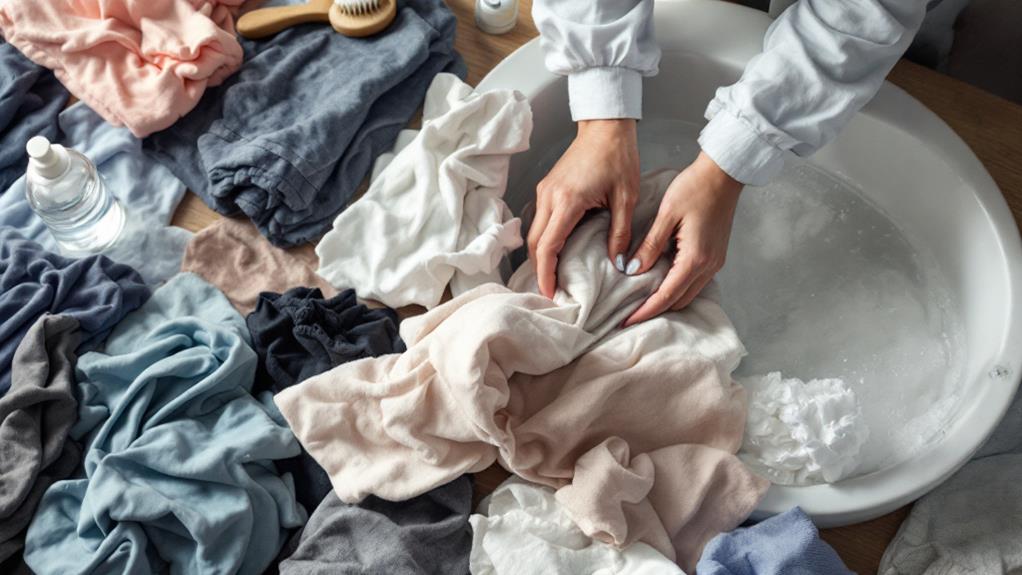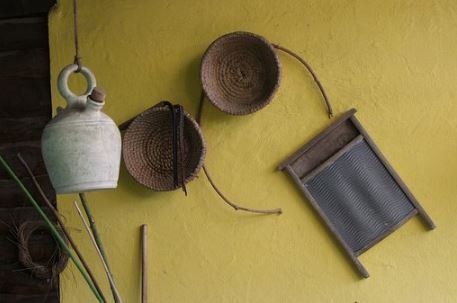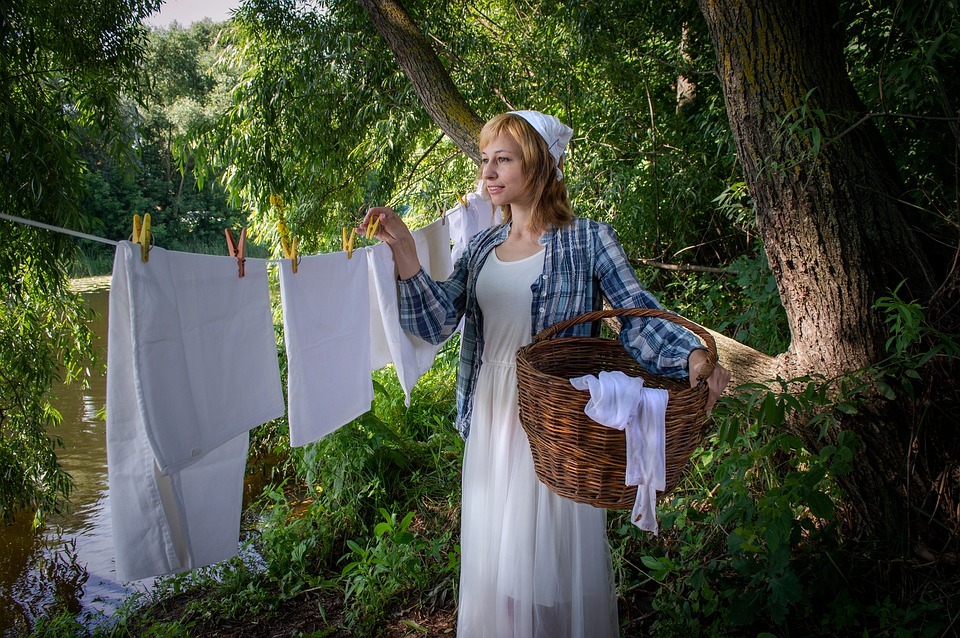Do You Need a Washboard to Wash Clothes by Hand?

You don't need a washboard to wash clothes by hand effectively. Basic hand-washing can be done with just a sink, mild soap, and your hands. While a washboard can be helpful for heavily soiled items, it's not essential for most laundry tasks. The key to clean clothes is proper technique, including gentle agitation and thorough rinsing. You can use alternative tools like a plunger or portable washing devices if you want extra scrubbing power. Hand-washing is gentler on delicate fabrics and can be more sustainable than machine washing. With the right approach, you'll be able to keep your clothes clean without relying on fancy equipment or complex techniques.
Understanding Hand-Washing Basics
Hand-washing clothes doesn't require fancy equipment or complex techniques. You can effectively clean your laundry using just your hands, a sink, and some mild soap. While a washboard can be helpful, it's not essential for successful hand-washing.
The key to clean clothes lies in commanding the basics. Start by filling your sink with lukewarm water and adding a gentle detergent suitable for the fabric you're washing. Submerge your clothes and gently agitate them with your hands, paying extra attention to areas prone to stains or heavy soiling. For tougher stains, you can use alternative tools like a plastic scrub board, a clean sponge, or even a plunger to provide additional agitation.
Water temperature plays a pivotal role in hand-washing. Use cool or lukewarm water for most items, reserving hot water for whites or heavily soiled clothes. Remember to rinse thoroughly to remove all soap residue. By focusing on proper technique and using the right soap, you can achieve clean, fresh-smelling laundry without relying on a traditional washboard. Hand-washing is an effective method for keeping your clothes clean, especially when dealing with delicate fabrics or small loads.
Essential Supplies for Hand-Washing
Now that you've grasped the basics of hand-washing, let's investigate the tools that can make the process more efficient. When it comes to laundry by hand, having the right supplies is indispensable. You'll need access to both warm and cold water, as well as two separate wash tubs or basins for washing and rinsing. A bar soap or liquid detergent is fundamental for cleaning your clothes effectively.
One tool that can substantially improve your hand washing experience is a washboard. While not absolutely necessary, a washboard, like those from the Columbus Washboard Company, can help you agitate fabrics more thoroughly, removing stubborn dirt and stains. It's particularly useful for heavily soiled items, allowing you to scrub them clean with greater efficiency.
However, it should be noted that a washboard may not be suitable for all fabrics. Delicate items could be damaged by the rough surface, so you might want to stick to soaking these in soapy water instead. For most other clothing, though, a washboard can be a valuable addition to your hand-washing arsenal, helping you achieve cleaner results with less effort.
The Two-Tub Method Explained

Having plunged into the essentials, it's time to immerse in the efficient two-tub method for hand-washing clothes. This approach is much more effective than using a single tub, especially on wash day when you're tackling multiple items without a machine.
The two-tub method involves using two different containers: one for soapy water and another for rinsing. You'll start by washing an item in the soapy tub, then move it to the rinse tub before tackling the next piece. This allows you to continually wash and rinse clothes without having to stop and refill a single tub between steps.
If you don't have two dedicated tubs, you can use a bathtub in a pinch. However, make sure to clean it thoroughly before washing your clothes. While a bathtub can work, it's not as efficient as using two separate basins.
When using the two-tub method, you'll be able to remove as much dirt and soap from your clothes more effectively. It's a time-saving technique that'll make your hand-washing experience smoother and more productive.
Effective Washing Techniques
With the two-tub method set up, it's time to command effective washing techniques. Start by filling your wash tub with soap and water. To clean most garments, gently swish them in the soapy water, avoiding harsh wringing or twisting. This method helps preserve your clothes' integrity and longevity.
For heavily soiled clothes, you might need to pre-treat stains or use a washboard for extra scrubbing action. However, remember that a washboard isn't essential for most hand-washing tasks. When dealing with delicate items like silk or cashmere, let them soak rather than agitating them vigorously.
After washing, transfer your clothes to the rinse tub. Make sure you've removed all detergent residue by thoroughly rinsing each item. This step is vital for maintaining the fabric's quality and preventing skin irritation.
Rinsing and Drying Strategies

The rinsing and drying phase is essential for completing your hand-washing routine effectively. After you've washed your clothes, it's time to rinse away the soapy water. Swirl and gently agitate your items in clear water to remove soap residue. If you're unable to fully remove all the soap, change the rinse water and repeat the process. This final rinse guarantees your clothes are free from any remaining detergent.
When you're satisfied with the rinse, squeeze your clothes lightly underwater to remove excess water. Be careful with delicate fabrics to avoid damaging them. Next, it's time to dry your freshly washed items. Hang them to air dry, preferably in sunlight, or use a drying rack or clothesline. As your clothes dry, keep an eye on them for any color bleeding or fabric damage.
Choosing Suitable Hand-Wash Items
Selecting the right items for hand-washing is essential to verify your clothes remain in good condition. Start by checking care labels to identify items suitable for hand-washing, and avoid those marked as dry clean only. You'll want to focus on lightweight, single-colored, and unlined garments. Steer clear of leather, suede, heavily embellished pieces, and those with bright or saturated colors.
If you're unsure about an item, perform a spot test to check for color loss or fabric distortion before proceeding. Remember, you can hand-wash clothes without a washing machine, including items like socks and bedsheets that are typically machine-washable.
When preparing to hand-wash clothes, separate them by color, fabric type, and how soiled they are. This will help you avoid color bleeding and validate thorough cleaning. By choosing suitable items and properly sorting them, you'll make the hand-washing process more efficient and effective. Once you've washed your clothes, find a spot to hang them for drying. With these tips, you'll be able to keep your hand-washed garments looking their best.
Preparing Clothes for Hand-Washing

Before diving into the hand-washing process, you'll need to properly prepare your clothes. Start by separating your garments based on color, fabric type, and how dirty they are. This step makes certain that delicate items and those good candidates for handwashing are treated with care.
Next, tackle any stains or yellowing using household ingredients like hydrogen peroxide or lemon juice. Pretreat these areas before washing to increase your chances of removing stubborn marks. For heavily soiled items like socks and underwear, soak them in warm water with laundry soap for at least 30 minutes to an hour.
Consider the water temperatures you'll use:
- Hot water for whites and heavily soiled items
- Warm water for most everyday clothes
- Cold water for delicates and dark colors
Remember to wash delicate items individually or with similar colors to protect their fibers. If you're dealing with heavy items, you might want to wash them separately to avoid damaging more delicate pieces. Finally, if you have limited drying space, consider washing smaller loads. This approach guarantees you'll have enough room to properly air dry your freshly cleaned clothes.
Alternative Tools to Washboards
With your clothes sorted and prepared, it's time to ponder your washing tools. If you don't have a washboard, don't worry! Your laundry room or bathroom offers several alternatives that work well for washing clothes by hand.
Your kitchen sink or a clean basin can serve as an excellent substitute, allowing you to gently agitate the fabric. A plastic tub or bucket also provides a surface for rubbing and scrubbing your clothes. For those seeking specialized options, portable devices like the Wonderwash or Laundry POD offer non-electric alternatives to traditional hand-washing methods.
To create the necessary agitation, you can use a plunger or rapid washer, eliminating the need for a washboard. Alternatively, simple hand-washing techniques, such as squeezing and swishing clothes in water with soap or detergent, can be just as effective. Remember not to use too much soap or water, as this can make rinsing difficult.
For drying, you can hang your clothes on a shower rod or outdoor clothesline. These alternatives facilitate the efficient washing of your clothes by hand without relying on a traditional washboard.
Benefits of Manual Laundry

While washing machines have become ubiquitous in many households, hand-washing clothes offers several distinct advantages. You'll find that manual laundry can be gentler on delicate fabrics, reducing the risk of stretching, snagging, or fading. This personalized approach allows you to give extra attention to stains and soiled areas, potentially achieving better cleaning results.
Hand-washing is also a more sustainable option, as it typically uses less energy and water than machine washing. You can further reduce your environmental impact by air-drying your clothes, which is not only energy-efficient but can also help extend the lifespan of your garments.
Greater control over the cleaning process, cost-effectiveness, especially in off-grid situations, and improved fabric care and longevity are three key benefits of manual laundry.
When hand-washing, you can easily customize your approach for different items like towels or delicate pieces of clothing. You can use hot water to remove bacteria more effectively, and natural additives like lemon juice or white vinegar to amplify cleaning power. By rinsing several times, you'll ascertain thorough cleaning without the need for harsh machine cycles.
Troubleshooting Common Hand-Washing Issues
Despite the benefits of hand-washing clothes, you might encounter some challenges along the way. One common issue is the need for a washboard to effectively clean heavily soiled items. While it's not strictly necessary, a washboard can considerably improve your cleaning power. If you don't have one, you can make do with alternative options like using your hands, a scrub brush, or creating a makeshift washboard from corrugated plastic or metal screens.
When you Wash Clothes by hand, you'll need hot water for best results, especially for stubborn stains. Use liquid detergent instead of powder to avoid residue. Make sure you're applying enough pressure and agitation, even without a washboard. If you find one, it'll make the process easier and potentially help your clothes last longer.




